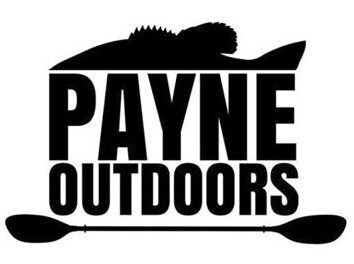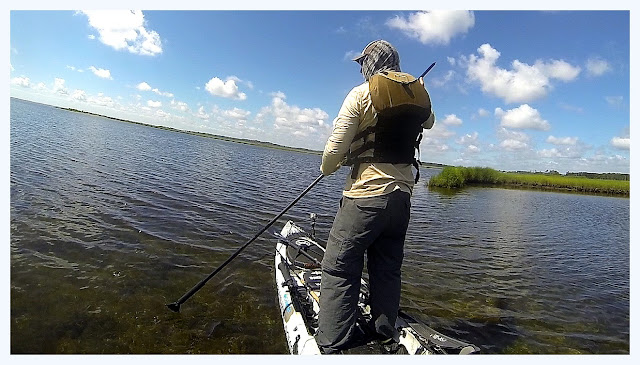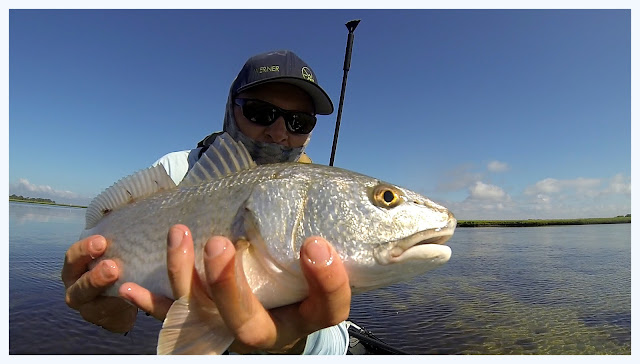- First thing that you MUST have is a quality pair of sunglasses! This cannot be stressed enough! If you cannot see the fish, you will have a difficult time to say the least. What a good quality pair of shades will do is help “brighten” your stalking grounds and eliminate surface glare that can otherwise blind the sight fisherman. The outline of a fish or the flicker of the tail is all you may see. Those that can pick out the minute details generally have a “higher than most” success rate. I use the Maui Jim Stingray with bronze lenses. These glasses enable me to be able to pick apart the flats and spot fish with ease.
- Yes you don’t need a skiff sized push pole, but having a kayak version push pole is a huge plus. This is where the 8′ YakAttack ParkNPole comes to play. Not only is this the best kayak stake out pole on the market, it doubles up to be an incredibly effective push pole. Flip the pole around and use the handle as the push pole foot to push off from. When you’re using it as a push pole and locate a fish, you can then flip it back around and slide the ParkNPole through your anchor trolley or scupper hole to keep stationary in even windy conditions.
- Silence is Golden! This saying holds true for the sight fishermen. If you’re in striking distance of an unsuspecting fish and drop your paddle or stake out pole to the deck, you can kiss that fish good bye. What many people fail to realize is that sound resonates through the water. The quieter you can move about your fishing platform, the better! Conseal is made up of sheets of stick-on foam that can be applied to almost any area of the kayak. Cut out pieces to stick on areas that may make contact with your paddle, stake out pole, and fishing rods. Not only does this dampen the sound of you laying down your gear; it is also great for traction.
Do you need the best pair of sunglasses or another stake out pole to add to the corner of the garage, no..? But do you want to catch more fish and enjoy your time while doing it? Now that we have discussed a few items that will help do the job, let’s figure out how to use them for success.
Weather is the biggest factor when it comes to sight fishing. Your flat could be loaded with hungry fish but clouds blocking the sun could put the brakes on any hopes of seeing the fish. Bright sunny, bluebird skies are what you need. It’s amazing how much you can see on the flats when the sun peeks out from behind the clouds. One important detail that you must consider is the position of the sun! You always want to keep the sun to your back. The reasons are quite simple; first it’s very difficult for the fish to see you if they’re staring at the sun. Picture lying on the ground while looking at the sun; everything between you and the sun is shadowed and you’re blinded. Secondly, it is a lot easier to dissect the flat with your eyes when the sun is at your back. This will help you spot the fish much easier. Keep in mind the angle of the sun as well. The lower the sun is, the more of a shadow you give off. A fish may have no idea that you’re there but once the shadow passes over them, they’re gone!
Another factor to keep in mind is the wind direction. A light wind can be a sight fishermen’s friend. A slight ripple on the surface allows the angler to get away with more movement (which we will cover in a bit). If possible, paddle or pole your kayak into the wind. “Into the wind” meaning the wind is hitting you in the face. The last thing you want is to gain speed and blow out an area because the wind pushed you into the fish. Going into the wind also helps when you stake out when you spot a fish. The wind will keep your kayak facing the direction you were going which helps to keep your eyes on the fish.
Along with the weather and wind is your tide cycle. In the areas that I regularly sight fish, I prefer the last 2 hours of the outgoing tide through the first 2 hours of the incoming tide. This is because it’s a lot easier seeing the transition areas and depressions that hold fish. The water is skinnier and makes it much easier to see the actual fish. Redfish for example will push bait into the back of bays and coves during low tide. What better sight is there than the glimpse of the blue tipped tails coming out of the water moving schools of baitfish into the shallows?
Keep it simple! You don’t need much tackle when you’re combing the flats. I like to use a 7′ medium light rod paired with a 2500 series reel. A fluorocarbon leader attached to your mainline is a must! These fish can be very skittish in skinny water. For most sight fishing outings, I use texas rigged plastics on a bass style worm hook. I have been having great luck using 1/16oz – 1/8oz Owner TwistLock hooks tipped with a 5″ Z-Manz Jerk Shadz. This setup is completely weedless and the slow fall rate of the Jerk Shadz keep the bait in the strike zone longer which make it very difficult for a hungry redfish to turn down.
Now that we have nailed down the pieces of the puzzle and figured out how to successfully stalk your target fish, it’s time to make it happen! This is the “make it or break it” moment. If you see the fish without spooking them, the ball is in your court. DO NOT make any crazy or sudden movements because most of the time you see these fish out of a kayak, they’re not more than 20 feet away. A smart redfish or any other predator fish will spot those movements more often than not. Slowly creep and lay down your paddle, push pole, or stake out very gently. Grab your setup and slowly stand just high enough to keep eyes on the fish. Remember, the higher you are, the more of a profile you give off. Make a slow, soft cast past the fish or out in front of it, keeping in mind to try and “lay” the bait in the water and not “splash” it in. This may take a little practice to get used to. Flipping and pitching bass fishermen know exactly what I mean by “lay” the bait in. If you can get the fish to spot your presentation without spooking, it’s almost money in the bank. Now it’s up to you to read the fish to see what makes them tick. Some will pounce on it, some may want to see some action.
Having all the tools in the world doesn’t mean something will get fixed. It’s how the tools are used that will produce different outcomes. It’s up to the dedicated kayak angler to take what they learned and apply it on the water. By putting these tips to use, you will be more successful in your sight fishing endeavors. Remember, you don’t want to throw a stick of dynamite during the moment of truth.
~See ya on the water!





.jpg)